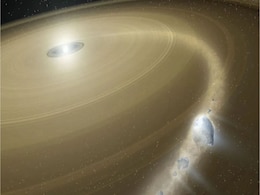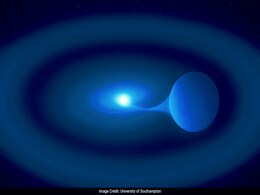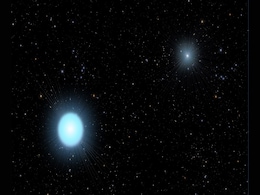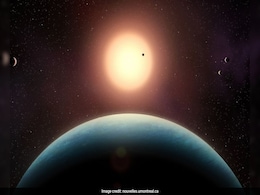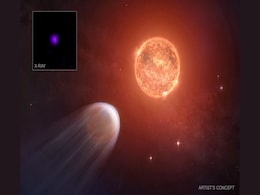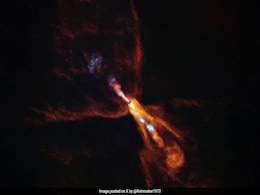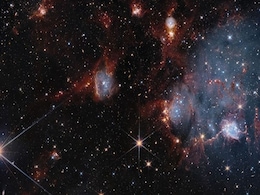Dwarf Star
- All
- News
-

TRAPPIST-1e Methane Signal Likely False, Webb Data Suggests Airless Planet
- Thursday December 11, 2025
The TRAPPIST-1 planetary system, located about 39 light-years from Earth, hosts seven rocky worlds orbiting a cool red dwarf star. While several of these Earth-sized planets lie in the star’s habitable zone, new observations from the James Webb Space Telescope suggest their atmospheres may be too thin to support life. Earlier hints of methane aro...
-
 www.gadgets360.com
www.gadgets360.com
-

Astronomers Spot First Coronal Mass Ejection from a Distant Star, Raising Questions About Planetary Habitability
- Monday November 17, 2025
Astronomers detected the first coronal mass ejection from a distant star, revealing that powerful stellar eruptions may strip atmospheres from nearby planets, affecting exoplanet habitability and the search for life.
-
 www.gadgets360.com
www.gadgets360.com
-

Newly Found ‘Super-Earth’ GJ 251 c Could Be One of the Most Promising Worlds for Alien Life
- Sunday October 26, 2025
A new super-Earth, GJ 251 c, has been found orbiting a nearby red dwarf star within its habitable zone. About four times Earth’s mass, it may host liquid water. Detected via the radial-velocity method using Penn State’s Habitable Zone Planet Finder, it’s a prime target in the search for life.
-
 www.gadgets360.com
www.gadgets360.com
-

Hubble Spots White Dwarf Devouring Icy Pluto-Like Planet 260 Light-Years Away
- Wednesday September 24, 2025
Using Hubble’s ultraviolet spectrograph, scientists detected carbon, nitrogen, sulphur, and abundant oxygen falling onto a white dwarf 260 light-years away, evidence of an icy planetesimal being torn apart. The find shows volatile worlds can persist into a star’s final stages, offering a preview of the Sun’s distant fate.
-
 www.gadgets360.com
www.gadgets360.com
-

Dead Star's Supernova Explosion Could Be Visible From Earth During Daytime, Study Predicts
- Sunday September 21, 2025
- Science |
When the two stars eventually smash into each other, the supernova explosion would be visible from Earth, even during daytime.
-
 www.ndtv.com
www.ndtv.com
-

NASA Hubble Space Telescope Uncovers One of the Youngest Known Blue Straggler–White Dwarf Systems
- Thursday September 11, 2025
Italian astronomers using the Hubble Space Telescope have discovered a white dwarf orbiting a blue straggler star in the globular cluster 47 Tucanae, located 15,300 light-years away. The rare system, among the youngest detected, sheds light on stellar mass transfer and offers vital clues to the evolution of binary stars in dense clusters.
-
 www.gadgets360.com
www.gadgets360.com
-

UY Scuti Reigns as the Universe’s Biggest Known Star, but Its Crown May Be at Risk
- Monday September 8, 2025
UY Scuti, a red hypergiant about 1,700 times the Sun’s radius, is the universe’s largest known star. Nearly 5 billion suns could fit inside its volume, but rivals like NML Cygni and Westerlund 1-26 challenge its claim to the crown. Astronomers stress that size estimates carry large uncertainties, leaving the title of biggest star still conteste...
-
 www.gadgets360.com
www.gadgets360.com
-

Ursa Major III May Be a Star Cluster, Not a Dark-Matter Dwarf Galaxy
- Sunday August 24, 2025
Astronomers have long thought Ursa Major III, also called UNIONS 1, was a dark-matter-packed dwarf galaxy. But new simulations suggest it may instead be a compact star cluster bound by black holes and neutron stars. Located 30,000 light-years away, Ursa Major III contains just ~60 visible stars yet shows puzzlingly high stellar velocities. The new ...
-
 www.gadgets360.com
www.gadgets360.com
-

Hubble Discovers White Dwarf Merger Remnant with Unusual Carbon Signature
- Friday August 22, 2025
An international team of astronomers has discovered WD 0525+526, an unusual white dwarf about 128 light-years away, using NASA’s Hubble Space Telescope. Unlike typical white dwarfs, this star formed through a stellar merger and shows an unexpectedly high carbon content. With a mass of 1.2 Suns and a scorching surface temperature of 21,000 K, the ...
-
 www.gadgets360.com
www.gadgets360.com
-

Young Exoplanet Spotted Shedding Atmosphere Under Stellar Radiation
- Thursday July 17, 2025
NASA’s Chandra X-ray Observatory and Hubble Space Telescope have captured a dramatic cosmic event: a baby exoplanet, TOI 1227 b, is being stripped of its atmosphere by powerful X-rays from its host star. Only 8 million years old and orbiting a red dwarf, this Jupiter-sized planet is losing gas at a rate equal to Earth’s entire atmosphere every ...
-
 www.gadgets360.com
www.gadgets360.com
-

Astronomers Capture Planet Birth Around Baby Sun Outside Solar System
- Thursday July 17, 2025
- World News | Associated Press
Astronomers have discovered the earliest seeds of rocky planets forming in the gas around a baby sun-like star, providing a precious peek into the dawn of our own solar system.
-
 www.ndtv.com
www.ndtv.com
-

NASA’s Hubble and Webb Discover Bursting Star Formation in Small Magellanic Cloud
- Saturday July 12, 2025
NASA’s Hubble and Webb telescopes have captured spectacular images of NGC 460 and NGC 456, two star clusters in the Small Magellanic Cloud. These young, open clusters are filled with massive, hot stars that trigger new star formation by carving nebulae. The findings provide insights into early universe conditions and interstellar medium behaviour...
-
 www.gadgets360.com
www.gadgets360.com
-

TRAPPIST-1e Methane Signal Likely False, Webb Data Suggests Airless Planet
- Thursday December 11, 2025
The TRAPPIST-1 planetary system, located about 39 light-years from Earth, hosts seven rocky worlds orbiting a cool red dwarf star. While several of these Earth-sized planets lie in the star’s habitable zone, new observations from the James Webb Space Telescope suggest their atmospheres may be too thin to support life. Earlier hints of methane aro...
-
 www.gadgets360.com
www.gadgets360.com
-

Astronomers Spot First Coronal Mass Ejection from a Distant Star, Raising Questions About Planetary Habitability
- Monday November 17, 2025
Astronomers detected the first coronal mass ejection from a distant star, revealing that powerful stellar eruptions may strip atmospheres from nearby planets, affecting exoplanet habitability and the search for life.
-
 www.gadgets360.com
www.gadgets360.com
-

Newly Found ‘Super-Earth’ GJ 251 c Could Be One of the Most Promising Worlds for Alien Life
- Sunday October 26, 2025
A new super-Earth, GJ 251 c, has been found orbiting a nearby red dwarf star within its habitable zone. About four times Earth’s mass, it may host liquid water. Detected via the radial-velocity method using Penn State’s Habitable Zone Planet Finder, it’s a prime target in the search for life.
-
 www.gadgets360.com
www.gadgets360.com
-

Hubble Spots White Dwarf Devouring Icy Pluto-Like Planet 260 Light-Years Away
- Wednesday September 24, 2025
Using Hubble’s ultraviolet spectrograph, scientists detected carbon, nitrogen, sulphur, and abundant oxygen falling onto a white dwarf 260 light-years away, evidence of an icy planetesimal being torn apart. The find shows volatile worlds can persist into a star’s final stages, offering a preview of the Sun’s distant fate.
-
 www.gadgets360.com
www.gadgets360.com
-

Dead Star's Supernova Explosion Could Be Visible From Earth During Daytime, Study Predicts
- Sunday September 21, 2025
- Science |
When the two stars eventually smash into each other, the supernova explosion would be visible from Earth, even during daytime.
-
 www.ndtv.com
www.ndtv.com
-

NASA Hubble Space Telescope Uncovers One of the Youngest Known Blue Straggler–White Dwarf Systems
- Thursday September 11, 2025
Italian astronomers using the Hubble Space Telescope have discovered a white dwarf orbiting a blue straggler star in the globular cluster 47 Tucanae, located 15,300 light-years away. The rare system, among the youngest detected, sheds light on stellar mass transfer and offers vital clues to the evolution of binary stars in dense clusters.
-
 www.gadgets360.com
www.gadgets360.com
-

UY Scuti Reigns as the Universe’s Biggest Known Star, but Its Crown May Be at Risk
- Monday September 8, 2025
UY Scuti, a red hypergiant about 1,700 times the Sun’s radius, is the universe’s largest known star. Nearly 5 billion suns could fit inside its volume, but rivals like NML Cygni and Westerlund 1-26 challenge its claim to the crown. Astronomers stress that size estimates carry large uncertainties, leaving the title of biggest star still conteste...
-
 www.gadgets360.com
www.gadgets360.com
-

Ursa Major III May Be a Star Cluster, Not a Dark-Matter Dwarf Galaxy
- Sunday August 24, 2025
Astronomers have long thought Ursa Major III, also called UNIONS 1, was a dark-matter-packed dwarf galaxy. But new simulations suggest it may instead be a compact star cluster bound by black holes and neutron stars. Located 30,000 light-years away, Ursa Major III contains just ~60 visible stars yet shows puzzlingly high stellar velocities. The new ...
-
 www.gadgets360.com
www.gadgets360.com
-

Hubble Discovers White Dwarf Merger Remnant with Unusual Carbon Signature
- Friday August 22, 2025
An international team of astronomers has discovered WD 0525+526, an unusual white dwarf about 128 light-years away, using NASA’s Hubble Space Telescope. Unlike typical white dwarfs, this star formed through a stellar merger and shows an unexpectedly high carbon content. With a mass of 1.2 Suns and a scorching surface temperature of 21,000 K, the ...
-
 www.gadgets360.com
www.gadgets360.com
-

Young Exoplanet Spotted Shedding Atmosphere Under Stellar Radiation
- Thursday July 17, 2025
NASA’s Chandra X-ray Observatory and Hubble Space Telescope have captured a dramatic cosmic event: a baby exoplanet, TOI 1227 b, is being stripped of its atmosphere by powerful X-rays from its host star. Only 8 million years old and orbiting a red dwarf, this Jupiter-sized planet is losing gas at a rate equal to Earth’s entire atmosphere every ...
-
 www.gadgets360.com
www.gadgets360.com
-

Astronomers Capture Planet Birth Around Baby Sun Outside Solar System
- Thursday July 17, 2025
- World News | Associated Press
Astronomers have discovered the earliest seeds of rocky planets forming in the gas around a baby sun-like star, providing a precious peek into the dawn of our own solar system.
-
 www.ndtv.com
www.ndtv.com
-

NASA’s Hubble and Webb Discover Bursting Star Formation in Small Magellanic Cloud
- Saturday July 12, 2025
NASA’s Hubble and Webb telescopes have captured spectacular images of NGC 460 and NGC 456, two star clusters in the Small Magellanic Cloud. These young, open clusters are filled with massive, hot stars that trigger new star formation by carving nebulae. The findings provide insights into early universe conditions and interstellar medium behaviour...
-
 www.gadgets360.com
www.gadgets360.com






